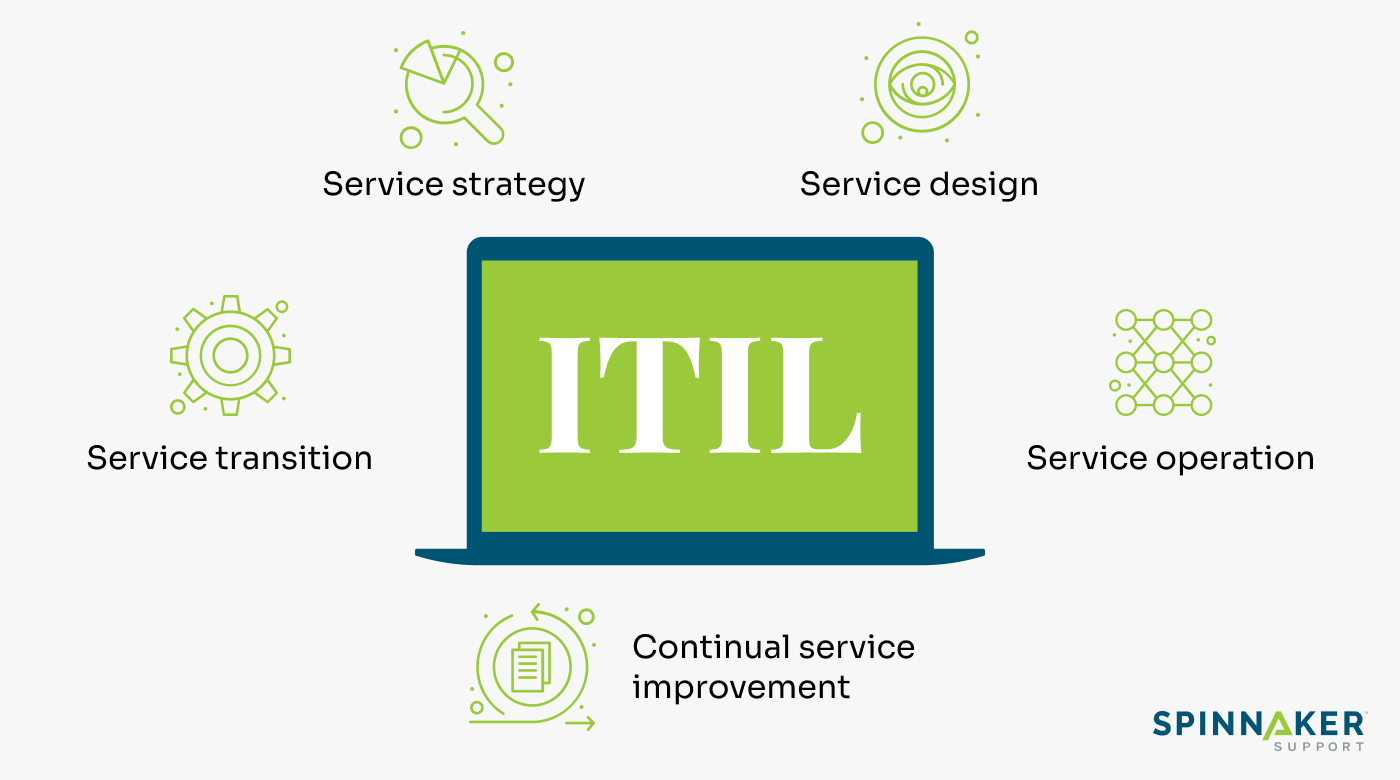
The digital world operates on the intricate orchestra of IT services, making their effective management crucial. One pivotal player in this field is the IT Infrastructure Library (ITIL), a set of comprehensive practices used in service management since the 1980s. ITIL essentially serves as the conductor that ensures harmony between your IT services and your business strategies.
The idea is to ensure IT services align closely with business objectives and are capable of adapting to changing needs and circumstances. Understanding these processes is crucial to successful IT service management (ITSM) and, ultimately, to boosting the overall performance of your business.
This article will take you through the intricacies of ITIL processes and explain you can integrate them into your IT strategies to drive business success.
Understanding the ITIL framework and its mechanisms
ITIL is structured in a multi-layered model that encompasses the service lifecycle and constituent stages. This model’s primary purpose is to align IT services with the needs of the business and deliver tangible value that increases customer satisfaction.
The layers of the ITIL framework
The service lifecycle within ITIL is a dynamic and iterative process, encompassing five key lifecycle stages (which we’ll unpack in detail in the next section). Each stage is interconnected and feeds into the next.
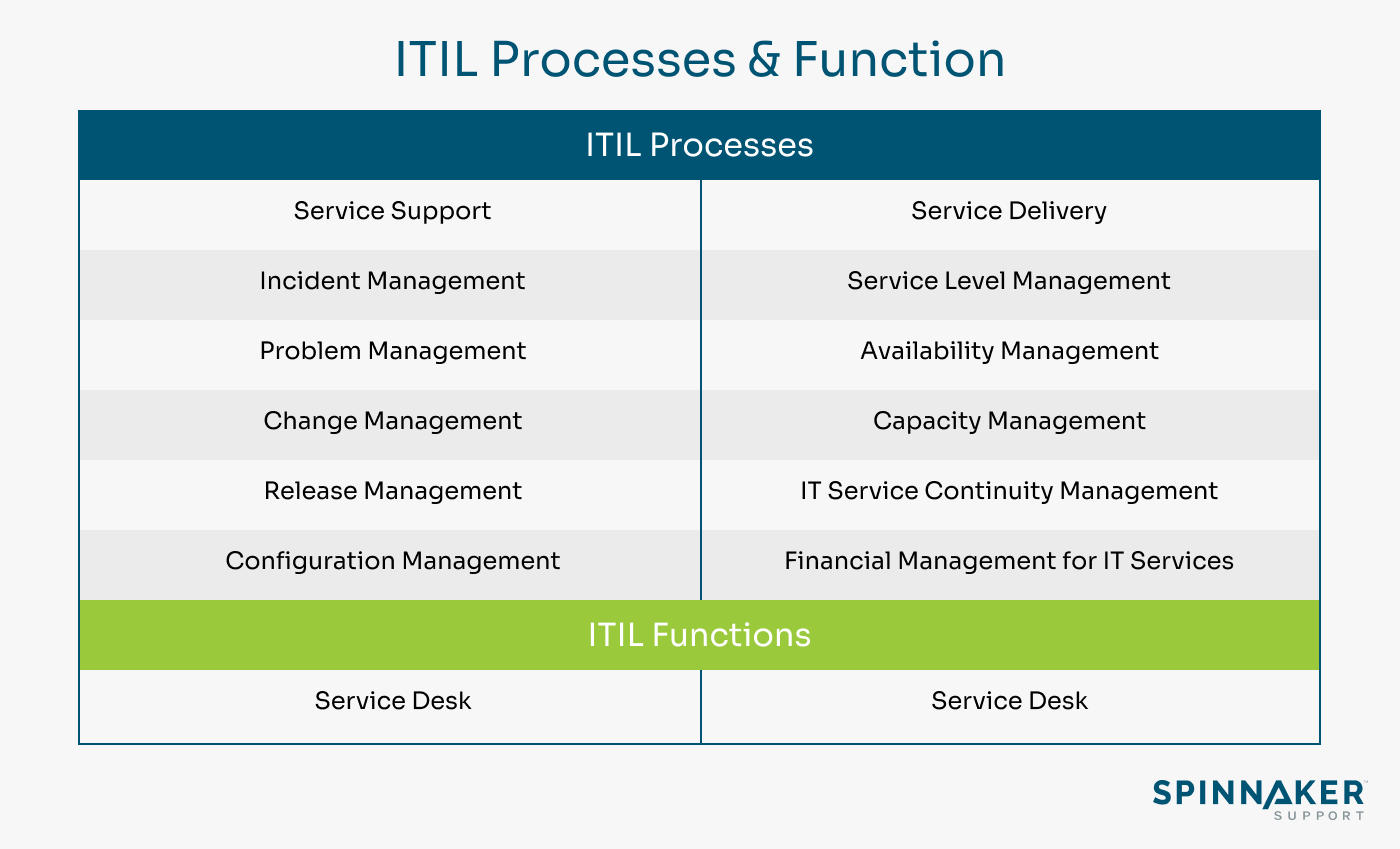
fundamental concept within the ITIL framework is the distinction between processes and functions. In ITIL terminology, a process is a set of activities to accomplish a specific objective.
Conversely, a function is a team or group that performs specific activities and tasks. Processes are strategic and goal-oriented, while functions are more operational, concerned with carrying out tasks.
The structure of ITIL: from lifecycle stages to service levels
ITIL defines the service lifecycle using five discrete stages. Each stage is integral to the service journey, serving a unique function and leading into the next. Collectively, these stages provide comprehensive guidance for service management activities, allowing for a holistic perspective that aids in the effective and efficient delivery of IT services.
- Service strategy: As the first and core stage of the ITIL framework, Service Strategy lays the foundation for all the following stages. This stage involves developing strategies for how IT services will be handled, such as defining which services will be offered and to whom.
- Service design: During the service design stage, the strategies from the previous stage become actionable plans. This includes service level management, information security management, capacity management, supplier management, service continuity management, and availability management.
- Service transition: The service transition stage is when the designs and plans developed in the last stage are built, tested, and transitioned into operations. This stage is characterized by activities such as transition planning, asset management, configuration management, deployment management, change management practices, service validation, and knowledge management processes.
- Service operation: As the name suggests, the service operation stage involves the day-to-day management and delivery of IT services. Processes in this phase include application management, incident management — often among the first ITIL processes adopted — and event management, among others.
- Continual Service Improvement (CSI): The final stage is never-ending, focused on continuous assessment and improvements of IT services and processes. It includes service measurement and reporting, risk management, and continuous service management processes.
In parallel to these lifecycle stages, ITIL also outlines five levels of effective service management. These levels shouldn’t be confused with the lifecycle stages — rather, they provide a framework for managing and resolving IT issues at varying depths of complexity.

Spinnaker Support’s breakdown of ITIL support levels for enterprise software
- Level 0 – Self-help: At this level, users are provided with self-service options and supported with technical resources that allow them to resolve simple issues independently.
- Level 1 – Basic service desk: Entry-level personnel handle this level, addressing common issues and escalating more complex problems. Help desk software tools, like the highly popular Zendesk or Zoho Support, are typically used here.
- Level 2 – Operational support: This level involves the resolution of more intricate operational issues handled by support staff who are well-acquainted with the product or system.
- Level 3 – Expert product support: Highly skilled product experts, who are well-versed in the system’s intricate issues and architecture, operate at this level.
- Level 4 – Specialized support: The highest level of support addresses advanced break/fix solutions, patches, and security management. Specialists, like those at Spinnaker Support who offer additional advisory services, manage this level.
Together, the lifecycle stages and service levels of ITIL create a comprehensive and seamless approach to managing IT services, making sure that your investment is optimized and your operational efficiency is improved.
Enhancing integration through ITIL
In our rapidly evolving digital age, it’s beneficial to combine the process-oriented nature of ITIL with other complementary practices. This hybrid approach can bring together the strengths of different methodologies, boosting versatility and robustness in service management. Some notable combinations include:
- Agile ITIL: This hybrid approach borrows the flexibility and iterative nature of the agile approach to software development, alongside the process-centric approach of ITIL. Agile ITIL emphasizes effective communication and collaboration, resulting in a responsive, continually-improving service management process,
- DevOps and ITIL: When DevOps and ITIL come together, they combine continuous software delivery with structured service management practices. This blend enhances service deployment speed and facilitates better coordination between the development and operations teams, leading to improved service quality and efficiency.
- ITIL and ITSM: Aligning ITIL with a broader ITSM context fortifies the overall service management landscape. This enables comprehensive service governance and management rooted in ITIL’s structured processes.
- ITIL 4 and older ITIL versions: By balancing the co-creation focus of ITIL 4 with the process-oriented approach of older ITIL versions, organizations can strike a balance between structure and innovation.
These hybrid approaches offer you the flexibility and adaptability to meet changing business requirements. Other benefits you might enjoy include enhanced collaboration across departments, accelerated service delivery, and the fostering of a culture of continuous improvement.
The managed services market is expected to exceed US$300 billion by 2027. With so many offerings to choose from, a third-party IT management service provider that follows the ITIL framework is essential. As a knowledgeable and trusted guide, Spinnaker Support can help you select and implement the right ITIL model for your organization.
From service continuity management and incident management to capacity management and deployment management, each process is adapted and optimized based on your specific requirements and context.
This bespoke approach ensures that every aspect of ITIL — from the service desk to security management — aligns perfectly with your needs, boosting overall efficiency and effectiveness.
ITIL processes: a key driver of successful digital transformation
A digital transformation fundamentally alters previous business operations by integrating technology throughout all facets of a business to better deliver value to customers. It often involves a shift in organizational culture, where experimentation and adaptability are encouraged.
By providing a framework for identifying, planning, delivering, and supporting IT services that meet the needs of the business, ITIL ensures that digital transformation initiatives aren’t only technologically sound but also aligned with business goals.
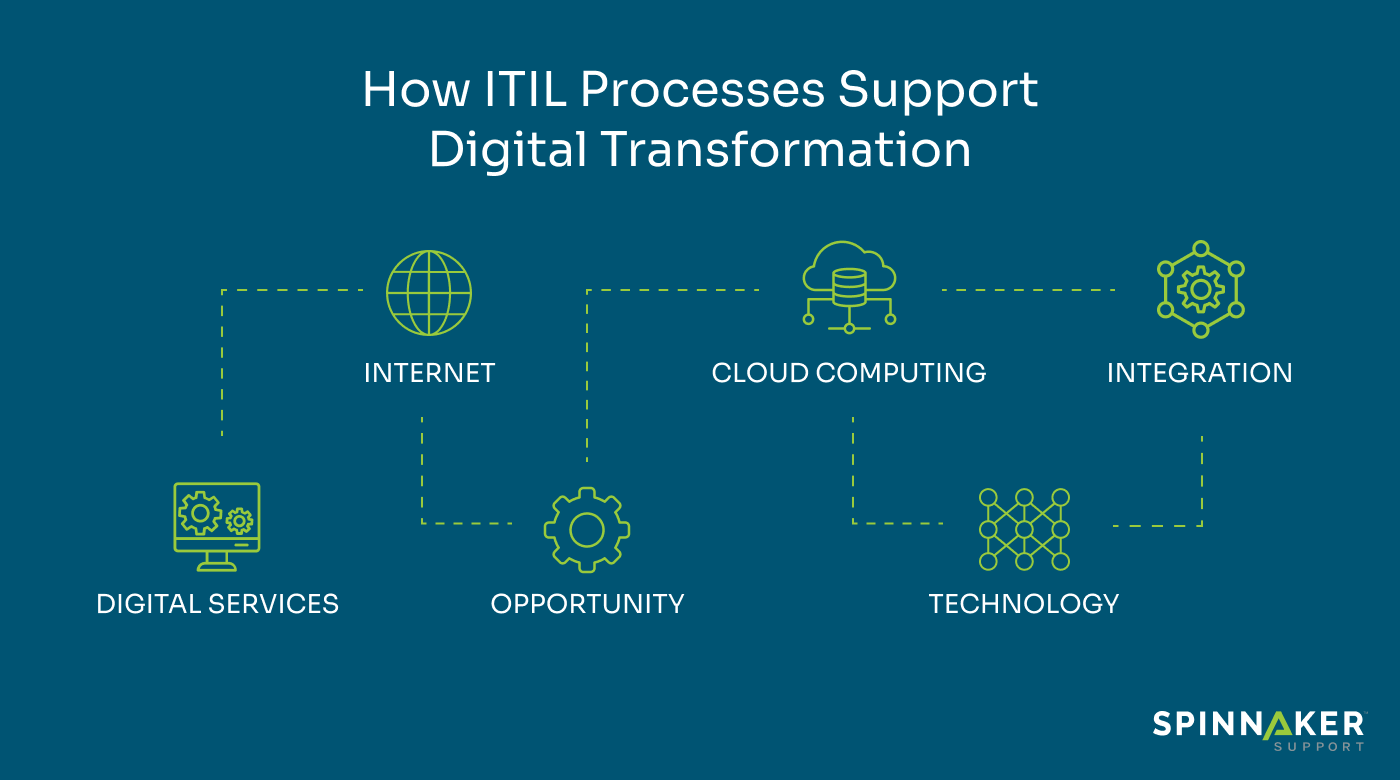
Let’s delve into how ITIL processes can bolster key digital transformation areas:
- Cloud adoption: ITIL can guide the transition to cloud technology. Processes like service transition, capacity management, and deployment management offer a structured approach to migration with minimal service disruption.
- Cybersecurity enhancements: The systematic nature of ITIL processes aids in enhancing cybersecurity. Asset management and security management practices, integral parts of ITIL, can help identify potential vulnerabilities and develop appropriate countermeasures.
- Implementation of emerging technologies: When incorporating AI, IoT, or other emerging technologies, ITIL offers vital support. For instance, capacity management can forecast the required resources, while the change management process provides seamless integration into existing systems.
Perhaps the most important ITIL process for digital transformation is operational change management. By facilitating effective communication, managing resistance, and driving the adoption of new technologies, this ITIL process can make or break a digital transformation initiative.
Moreover, service requests and service validation processes can support the ongoing improvement of digital services. They help in gauging the effectiveness of digital initiatives and identifying areas for enhancement.
Pivotal ITIL processes behind effective ITSM
Effective IT service management is dependent on the successful implementation of ITIL processes. Whether you’re interested in digital transformation, continuous improvement, or deploying a hybrid ITIL model customized for your organization, a trusted third-party support provider like Spinnaker can offer the expertise you need.
Processes related to third-party support
- Incident management: Efficient resolution of IT service disruptions is possible through a well-structured incident management process, guaranteeing minimal operational impact.
- Problem management: Addressing the root causes of recurring incidents is key to reducing their overall impact on IT services.
- Change management: A comprehensive change management process makes sure changes are planned, tested, and implemented effectively, mitigating risk and disruption.
Processes related to hybrid approaches
- Service Integration and Management (SIAM): Managing multiple service providers requires effective integration and coordination facilitated by the SIAM process.
- Agile IT service management: Incorporating Agile methodologies into ITIL processes can boost flexibility and collaboration, enhancing the speed and responsiveness of service delivery.
- DevOps integration: Merging ITIL with DevOps practices can streamline the development, deployment, and operation of IT services, fostering faster delivery and improved collaboration.
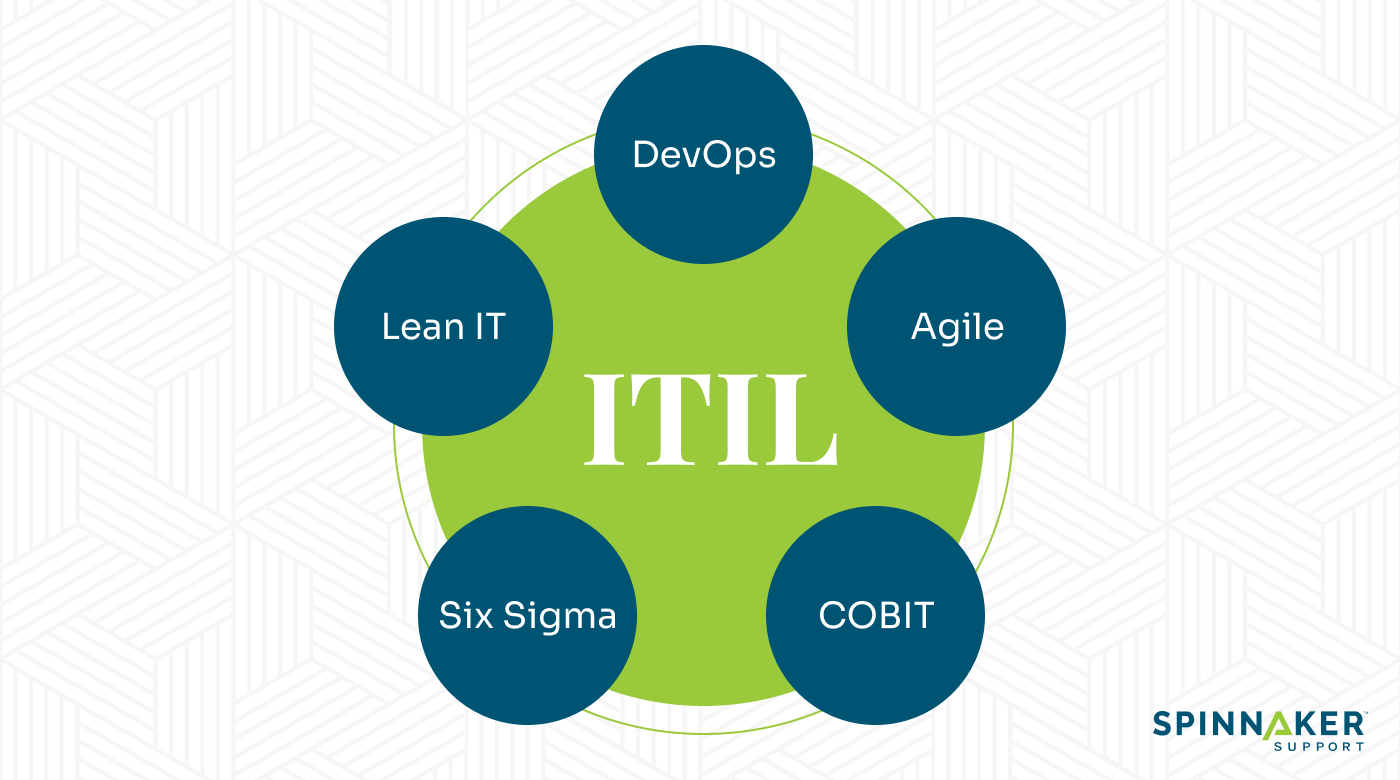
Processes related to digital transformation
- Service portfolio management: Effective management and alignment of IT services with evolving digital transformation initiatives can be realized through service portfolio management.
- IT service continuity management: Protecting the resilience and availability of critical IT services during transformation initiatives is a must, facilitated by continuity management processes.
- Service catalog management: Implementing a clear catalog of IT services to support digital efforts promotes self-service and transparency.
Processes related to continuous improvement (CSI)
- Measurement and reporting: Collecting data, measuring performance, and generating insights for continuous improvement efforts are possible through effective measurement and reporting processes.
- Service level management: Implementing service level management processes helps in setting and monitoring service level agreements (SLAs), making sure services meet the agreed-upon performance targets.
- Knowledge Management: Implementing a knowledge management strategy facilitates continuous learning and improvement, capturing, storing, and sharing knowledge within the IT environment.
Spinnaker Support’s implementation of these ITIL processes depends on the unique needs, goals, and IT environment of each client. This tailored approach allows for more effective IT service strategy management optimized to the specific context and demands of your organization.
Crafting effective ITIL implementation: best practices and key considerations
Implementing ITIL processes can dramatically improve an organization’s IT service management capabilities. However, to maximize the benefits of ITIL, it’s crucial to consider your unique business requirements, existing business processes, and objectives. Here’s a consolidated list of best practices and considerations to guide the effective implementation of ITIL processes.
- Understand business objectives: Begin by identifying your organization’s goals and how IT services can support them. Identify areas where IT services significantly impact business objectives or are crucial for achieving these goals.
- Evaluate service requirements: Identify the specific services your organization provides or plans to offer. Consider your customers’ expectations for service availability, performance, security, and other critical aspects.
- Analyze existing processes: Evaluate your existing IT service management processes, pinpointing strengths, areas of improvement, and any compliance requirements that need addressing.
- Engage stakeholders: Include key stakeholders like business leaders, IT teams, service desk personnel, and customers in the process. Their input can provide a comprehensive understanding of your organization’s IT service management needs and priorities.
- Review ITIL framework: Familiarize yourself with the ITIL framework and its various processes. Understand the purpose, objectives, and activities associated with each process.
- Prioritize and select processes: Prioritize the ITIL processes that’ll significantly impact your service delivery and IT alignment with business goals based on your analysis of business objectives, service requirements, and existing processes.
- Customize and adapt: Tailor the selected ITIL processes to fit your organization’s specific needs, culture, and available resources. Avoid implementing processes blindly; instead, adapt them to suit your unique requirements.
- Plan and implement: Develop a detailed implementation plan where you outline steps, timelines, and responsibilities for deploying the chosen ITIL processes. Communicate the plan across the organization, provide necessary training, and ensure effective change management practices are in place.
- Continual improvement: Embrace ITIL’s ethos of continual improvement. Track the effectiveness of the implemented processes, collect feedback, measure performance, and make necessary adjustments over time.
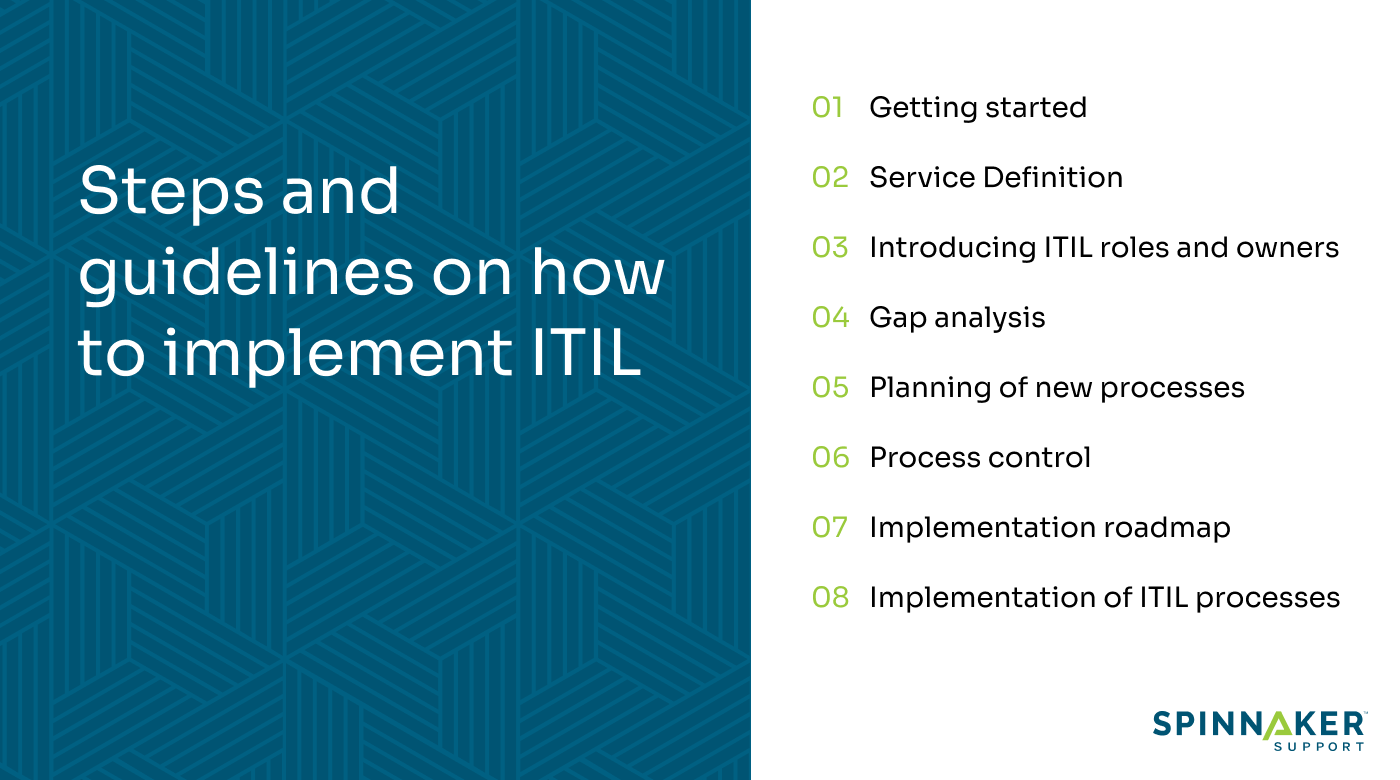
Don’t just adapt to the digital age – master it!
Mastering ITIL processes isn’t just about keeping up with the latest tech trends. It’s about shaping your IT services to lead the field, innovate, and exceed the expectations of both your customers and your own business. It’s about making your IT services so seamless, efficient, and effective that they become a pivotal part of your organization’s success.
As always, we’re here to help. Spinnaker Support is your partner in this journey, providing tailored ITIL processes to meet your unique needs and guiding you every step of the way to ensure an optimal fit between these processes and your business-critical requirements. Let us help you master IT service management because your success is our success.


